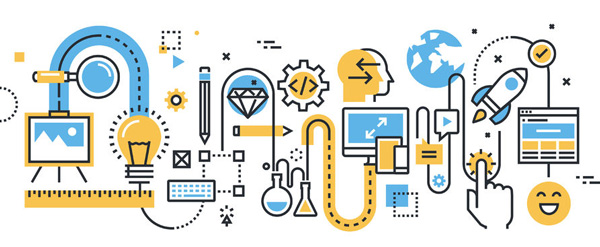What’s the biggest shift in advertising in the last 10 years?
Would you say “digital”? Maybe “social”? One word that probably didn’t pop into your head was “interactive.” For a User Experience Designer like myself, the absence of that phrase in the agency space is a curiosity. “Digital” is just a technology; even billboards have gone digital. “Social” is a channel, a pathway of communication like radio, print or broadcast. But “interactive” is a descriptor of the content (vs “static” and “dynamic” for content) or of the property and how people use it. It’s a simple reason why digital folks often call our audience “users” instead of “consumers.” It’s also why user experience designers exist at all.
In the last 20 years, a LOT has changed with technology. Content became dynamic and interactive with users contributing to the content of the page. Sites became more interactive, providing users with reactions to their actions. Mobile devices caused the rise of responsive design, meaning now even the presentation of information and the visual design became dynamic. They also created a new space for pure content consumption when new channels opened up with social media. Hell, we have apps! Even the static images that once passed as advertisements became animated and interactive. Advertising and digital marketing became a two-way conversation, not a sales pitch.
We ALL know this, right? So why talk about it now? Just like some agencies still talk about digital like it’s a separate thing, no one’s talking about interactive. And that’s the root of our problems in making the transition to full-service agencies trying to take on digital. Last year, Dan Wieden said the transition into the digital ad world would transform his agency or “Render us inert” and we know W+K isn’t the only agency, big or small, trying to figure it out. The hump to get over isn’t training designers to work in RGB at 72ppi (or 144, etc). It’s not even training creatives that no format is static anymore, and designing for a single screen size and format doesn’t work anymore. The hump is training or hiring people who “think digitally.”
From the word go, everyone on a digital project needs to be thinking about how any creative ideas work in the digital space. Who are we targeting (because we can)? How will those target users react to it, interact with it? How do they get there and where do they go afterwards? What do they get from it, what can they give to it, and why should they give a shit in the first place? What’s the next iteration (because we know anything digital, like most undead creatures,keeps going unless you cut double-tap it and off its head)? And who’s responsible to keep it all going in a way that’s GOOD for our clients? These questions are why Think With Google suggested that UX and Strategy should be working together from the beginning.
As the project moves along even more questions arise. How does the experience change between mobile and desktop? Are the users’ needs different between the two, or different based on their location and how? How do users flow through this product in the best possible way? How is the information organized and presented to achieve the goal of each specific screen? Are we paying attention to the different ways it will get used by different people depending on all the answers to the previous paragraph? The Devil is in these details, and they are precisely the details UX was created to sweat.
Pure digital agencies understand this. But more importantly, software and app developers and e-commerce companies all understand this. They rely on good UX to make sure their products are loved and used so they stay in business. UX is baked into a process in order to deliver (and iterate) the best possible experience. But in an industry where “ideas are everything,” this idea seems to be lagging behind. This is no way to suggest that the ideas, branding, and messaging that falls in the Creative province are less important than the experience. The core of advertising is still the great idea. A great execution of a bad idea is still a bad idea. However, as MediaMonks co-founder Wesley ter Haar has said “Great ideas simply don’t survive bad user experiences.”
So assuming your agency has accepted the idea and value of UX, how do you go about evolving to take advantage of it? There’s been a lot said about UX fitting into ad agencies. UX Magazine even published a guide on How to Succeed as an Experience Designer in Advertising. And I can say from experience that it’s all pretty good advice, especially the bits about early and continuous collaboration. However, it’s also an acceptance of old rules being applied to a new game: retrofitting UX (and other interactive roles) into a process only meant to produce static content. And in the worst of cases, run by people who only truly understand the one-way sales pitch. The need isn’t for a transition, a slow retooling of the old agency structure and processes. It’s a call to revolution to accelerate evolution. Remember…
It is not the strongest of the species that survives, nor the most intelligent that survives. It is the one that is most adaptable to change.
But if the fear of a long, slow, painful death of standing still while the digital world passes by isn’t enough motivation to fully integrate UX, here’s the push I know will work for even the most traditional of Creative Directors. Cannes Lions have announced award categories for Digital Craft including Function: Design, Construction and Experience. It’s a bit of an official “UX Matters” stamp for the industry. And it means a digital execution can win a coveted Lion even without the great idea. But more importantly, it means that a great idea with great UX can win even MORE awards. How’s THAT for making a case for UX in advertising?
